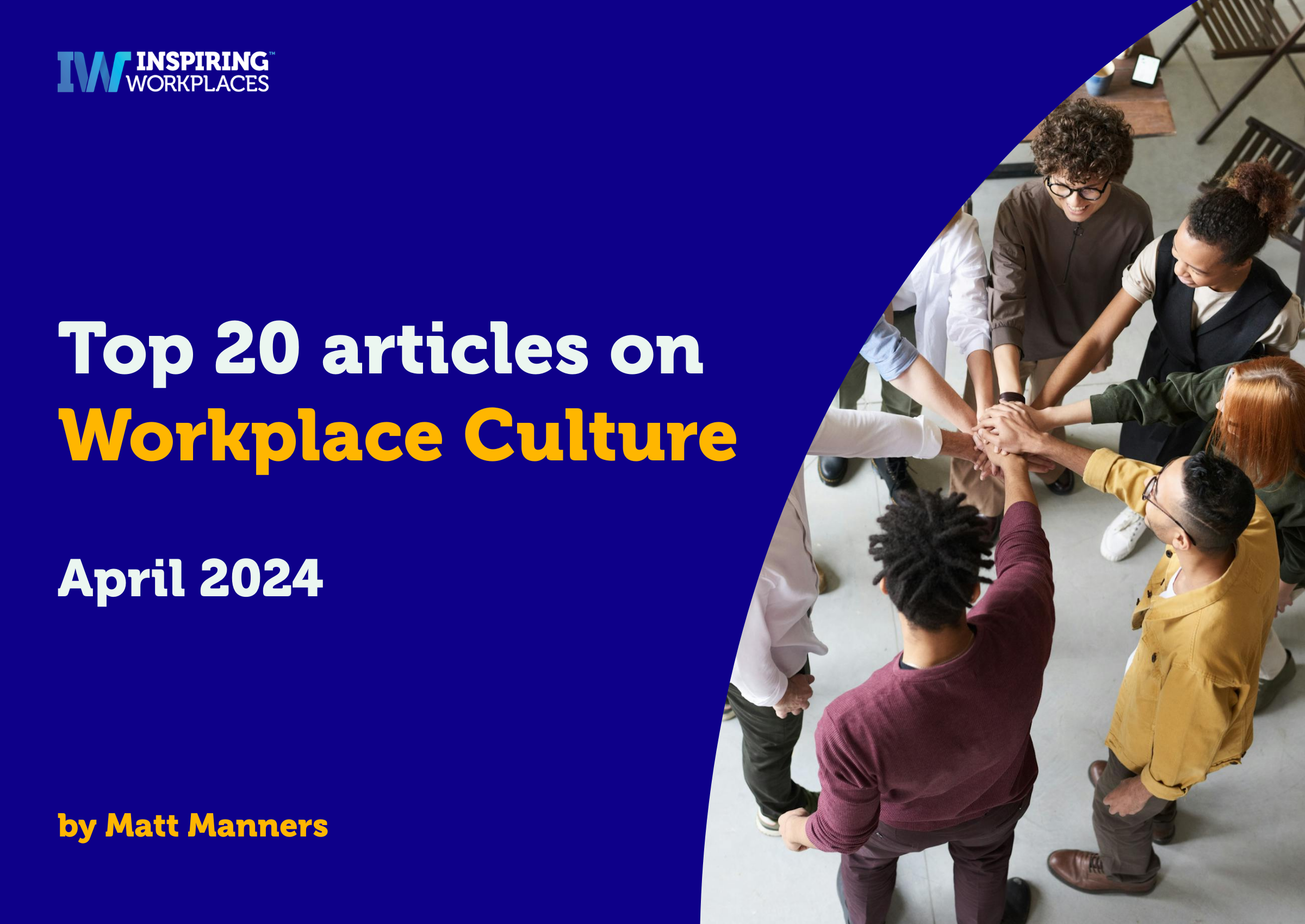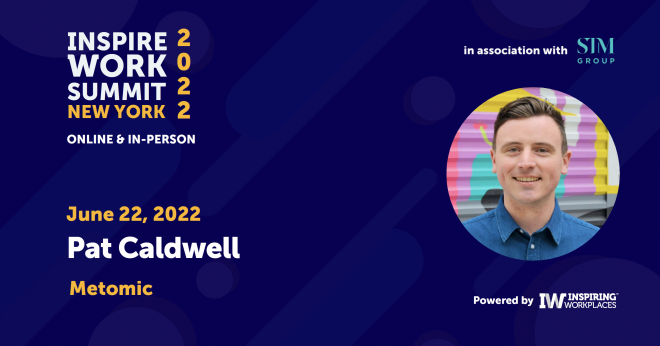
07th May 2024
Top 20 Articles on Workplace Culture: April 2024

Welcome to the Inspiring Workplaces Top 20 Articles on Workplace Culture for April 2024.
We want to help inform and inspire you from some of the best content out there. Each month we will consolidate these articles for you to help give you a quick and easy snapshot. To help drive you and your organisations forward.
The articles will be underpinned by seven key elements that are reflected in our bespoke COMPASS methodology, that also underpin the Top Inspiring Workplaces worldwide. They are:
- Wellbeing
- Culture & Purpose
- Leadership
- Inclusion
- Employee Experience
- Communication & Voice
- Society & Sustainability
Key Workplace Culture Learnings for April:
Key Workplace Culture Learnings for April:
- Prioritizing Employee Satisfaction: Enhancing employee satisfaction through better work conditions and benefits is crucial as it leads directly to improved customer service, boosting both profitability and business reputation.
- Supportive Work Environments: Incorporating flexible work arrangements, mental health support, and continuous learning opportunities can significantly enhance employees’ job satisfaction and productivity, positively affecting the organization’s reputation and effectiveness.
- Mitigating Toxic Leadership: Effective leadership should avoid micromanagement and foster open communication, with a focus on compassionate leadership styles to improve employee satisfaction and retention.
- Investment in Employee Experience: High investment in employee experience (EX) correlates with better business outcomes, including customer satisfaction and increased productivity, through supportive and inclusive environments.
- HR’s Strategic Role in Workspace Design: Post-COVID-19, HR plays a pivotal role in shaping workspace design to support collaboration, culture, and employee well-being, influencing real estate decisions and workspace customization.
- Importance of Psychological Safety: Fostering a culture where every voice is valued and encouraged enhances collaboration, innovation, and productivity, transforming workplace dynamics and promoting continual progress.
- Compassionate Leadership in Corporate Wellness: Compassionate leadership is vital for the success of corporate wellness programs, reducing turnover rates, and enhancing engagement and organizational morale.
- Aligning Employer Branding with Cultural Realities: Effective employer branding aligns with the real cultural environment of the workplace, helping to attract the right talent and promote company culture.
- Employee Experience as a Holistic Journey: EX encompasses all aspects of an employee’s journey within an organization and optimizing it is key for attracting and retaining talent, which enhances productivity and preserves a positive employer brand.
- Communication and Flexible Working Policies: Transparent communication about flexible working policies and training managers to accommodate employee needs are essential for reducing workplace stress and fostering a culture of respect and inclusivity.
The articles are as follows…
A corporate culture that focuses on holistic wellness helps workers thrive and achieve peak performance
Source: Wellness Done Well
Authors: Jessica Abshire
IW COMPASS point: Wellbeing
Key Takeaways
- Employee experience (EX) is crucial in the hospitality industry for enhancing customer satisfaction and overall business success.
- A positive employee experience impacts all aspects of the business, from recruitment and retention to daily operations.
- Investing in employee satisfaction leads to better customer service, which in turn increases profitability and enhances the brand’s reputation.
- The article advocates for a strategic focus on improving work conditions and providing benefits to boost employee morale and efficiency.
Read the full article here
4 Guidelines For Managers To Redeem Their Careers As ‘The Workplace Villain’
Source: Forbes
Author: Bryan Robinson
IW COMPASS point: Leadership
Key Takeaways
- Toxic leadership can overshadow positive work experiences, leading to employee turnover.
- Around 57% of employees have quit jobs due to poor management.
- Leadership should encompass empathy and transparency, recognizing employees as whole individuals with diverse needs.
- Creating a culture of feedback and open communication can mitigate toxicity.
- Managers should avoid micromanagement and promote a supportive and inclusive environment.
- Engaging in continuous improvement and listening to employee feedback are crucial for fostering a healthy workplace.
Read the full article here
Essential workplace culture books for startup founders
Source: Inspiring Workplaces Guest Blog
Authors: Rachel Pipan
IW COMPASS point: Culture & Purpose
Key Takeaways
- Culture as a Product: The founder is the chief architect of company culture. Creating an inspiring workplace is crucial for attracting and retaining extraordinary employees, as highlighted by Netflix’s Reid Hoffman.
- Cultural Understanding: Erin Meyer’s book The Culture Map provides guidance on effective cross-cultural communication, crucial for tech companies with global aspirations.
- Effective Relationships: Dale Carnegie’s How to Win Friends and Influence People offers timeless advice on building genuine relationships and ensuring people feel heard, essential for founders managing investors, customers, and teams.
- Constructive Feedback: Kim Scott’s Radical Candour navigates the balance between indirect and overly blunt feedback, providing frameworks to maintain transparent yet motivating conversations.
- Text Communication: Founders heavily reliant on email and messaging can improve their written communication with The Elements of Style by Strunk and White.
- Time Management: Daniel H. Pink’s When emphasizes optimizing personal schedules for productivity and decision-making, fostering better time management for leaders and their teams.
- Proactive Culture Building: Start shaping a strong workplace culture from day one, creating a foundation capable of supporting a startup’s growth and challenges.
Read the full article here
Why your employee experience matters as much as your guest experience
Source: Hospitality Net
Authors: Book4Time Inc.
IW COMPASS point: Employee Experience
Key Takeaways
- Employee experience (EX) is as crucial as customer experience in hospitality, significantly impacting retention and satisfaction.
- Research shows that a strong EX correlates with higher innovation, profitability, and customer satisfaction.
- Effective EX requires ongoing investment in digital technologies and leadership behaviors that support collaboration, creativity, and empowerment.
- Higher investments in EX yield notable improvements in business metrics like customer satisfaction, employee outlook, and productivity.
- Practical steps to enhance EX include creating inclusive environments, offering flexible work schedules, industry-specific training, and comprehensive well-being programs.
- These efforts in improving EX can lead to increased bookings, customer satisfaction, and overall revenue growth.
Read the full article here
HR’s role in shaping modern workspaces and real estate
Source: THE SAVILLS BLOG
Author: Clare Bailey and Robert Pearson
IW COMPASS point: Leadership
Key Takeaways
- The COVID-19 pandemic has prompted businesses to rethink workspace design and utilization.
- HR plays a crucial role in shaping modern workspaces by considering employee needs and preferences.
- Workspaces are strategic assets that can foster collaboration, culture, and employee well-being.
- HR gathers insights through employee feedback and data analysis to inform real estate decisions.
- Certifications like BREEAM and FitWel help evaluate the impact of workspace design on employee well-being.
- HR’s involvement ensures that real estate decisions align with organizational goals and employee expectations.
- A data-centric approach allows HR to tailor workspaces to meet evolving workforce needs and enhance productivity.
- HR’s strategic role in workspace design will continue to be vital as organizations navigate hybrid work models and changing employee expectations.
Read the full article here
Unlocking people potential with psychological safety
Source: HGR
Author: Simon Daly
IW COMPASS point: Wellbeing
Key Takeaways
- Psychological safety is crucial in today’s workplaces for unlocking teams’ potential and driving success.
- It fosters an environment where every voice is valued and encouraged, leading to enhanced collaboration, innovation, and productivity.
- Strategies such as framing work as a collaborative learning process, admitting fallibility, and encouraging open dialogue can help achieve psychological safety.
- Removing hierarchy from communication, welcoming challenges, and seeking feedback regularly are essential steps.
- Persistence in implementing these protocols can gradually transform individual habits into collective culture, fostering continual progress and making the organization an employer of choice.
Read the full article here
The Importance of Compassionate Leadership in Corporate Wellness
Source: CORPORATE WELLNESS
Author: Elizabeth Hawthorne
IW COMPASS point: Leadership
Key Takeaways
- Compassionate leadership significantly influences employee well-being and the success of corporate wellness programs.
- It involves prioritizing employees’ needs with empathy and thoughtful action.
- Benefits of compassionate leadership include enhanced employee engagement, lower turnover rates, fostered team collaboration, and effective crisis management.
- Strategies for cultivating compassionate leadership include comprehensive training, open feedback channels, leadership by example, and inclusive wellness programs.
- Implementing compassionate leadership enhances organizational productivity, morale, and overall success.
Read the full article here
“Investing in your employer brand will attract and retain the right talent and improve your bottom line” says Employer Branding expert
Source: lovebelfast
Author: Staff Writer
IW COMPASS point: Culture & Purpose
Key Takeaways
- Renowned employer branding expert Bryan Adams emphasizes the importance of focusing on cultural realities rather than perceived ideals in employer branding.
- The event highlighted the significance of developing a strong employer brand to attract and retain talent in a competitive job market.
- Insights from a bespoke research study revealed that candidates prioritize a culture of accountability, flexible working options, and supportive environments for learning and development.
- Organisations need to communicate their mission, values, and culture effectively to retain and attract top talent.
- The discussion panel included experts from employer marketing agencies, employee communications platforms, diversity and inclusion authorities, and talent development firms, presenting insights on various aspects of fostering a happy workforce.
Read the full article here
What is Employee Experience
Source: Techopedia
Author: Tim Keary
IW COMPASS point: Employee Experience
Key Takeaways
- Definition of Employee Experience (EX):
- EX refers to the overall experience an employee has with an organization throughout their entire lifecycle.
- It encompasses recruitment, onboarding, day-to-day responsibilities, development opportunities, and offboarding.
- Factors Influencing Employee Experience:
- Type of work completed, working environment, culture, relationships with coworkers, management style, pay, benefits, and paid time off.
- Importance of Employee Experience:
- Essential for attracting top talent and ensuring employee retention.
- Positive EX leads to increased productivity, job satisfaction, and reduced turnover rates.
- Critical for preserving a company’s employer brand and reputation.
- Positive Employee Experience Strategies:
- Offer flexible working arrangements, personalized development opportunities, unlimited paid time off, and employee wellness programs.
- Focus on building a supportive and inclusive work environment.
Read the full article here
How To Measure Employee Engagement
Source: HR Director
Author: Sam Monteath
IW COMPASS point: Leadership
Key Takeaways
- Employee engagement surveys serve as a compass, indicating whether organizations are heading in the right direction regarding employee satisfaction and commitment.
- The purpose of measuring engagement is not just to obtain a numerical value but to understand the conditions that contribute to engagement.
- Different survey providers may measure engagement differently, leading to discrepancies in reported engagement levels.
- Engage for Success outlines four enablers of engagement: strategic narrative, engaging managers, employee voice, and organizational integrity.
- While surveys are valuable for gathering feedback from the majority of the workforce and tracking changes over time, they have limitations in benchmarking against other organizations and identifying the reasons behind responses.
- Surveys typically provide quantitative data but lack insights into the qualitative aspects of engagement.
- Employers should balance survey data with other methods such as focus groups, interviews, and open forums to gain deeper insights into employee sentiment.
- External assistance can provide unbiased perspectives and help organizations better understand their engagement landscape.
- Traditional survey formats may evolve to incorporate voice notes or video clips for more authentic responses and AI-driven analysis for deeper insights.
- The ultimate goal of measuring engagement is to understand the reasons behind the numbers and take actions to enhance employee satisfaction and commitment.
Read the full article here
Your Employer Brand Is Your Brand: The Power Of The CPO And CMO Relationship
Source: Forbes
Author: Cara Brennan Allamano
IW COMPASS point: Leadership
Key Takeaways
- The partnership between a Chief People Officer (CPO) and a Chief Marketing Officer (CMO) is vital for aligning internal culture with external brand messaging.
- The convergence of internal employee sentiment and external branding efforts underscores the importance of collaboration between the CPO and CMO.
- A successful partnership ensures that the organization’s values are authentically reflected both internally and externally.
- Effective communication and storytelling are essential components of the CPO’s role, reinforcing the company’s focus, culture, and commitment to its values.
- Leveraging employee voice as brand ambassadors strengthens the bilateral relationship between the CPO and CMO.
- Metrics such as employee engagement scores, brand sentiment analysis, and recruitment success rates measure the effectiveness of internal culture in shaping the external brand image.
- Collaborative efforts between the CPO and CMO create an ecosystem where employee experience is not just a nice-to-have but a business-critical need.
Read the full article here
Employers report a values and skills mismatch with younger workers
Source: The open university
Author: Guest Author
IW COMPASS point: Wellbeing
Key Takeaways
- A survey by The Open University shows a shift in young people’s workplace values due to pandemic-induced lack of work experience.
- Employers struggle to recruit and retain young talent, with a mismatch between skill levels and expectations.
- Top benefits requested by young workers include flexible working, salary increases, hybrid work options, wellbeing support, and mentoring opportunities.
- Employers should focus on improving morale and mental wellbeing to attract and retain young talent.
- Young people prioritize short courses, mentoring/coaching, online courses, vocational qualifications, and apprenticeships for learning and development.
- The Open University is hosting an event, ‘Elevate Equity: Harnessing Young Talent,’ to explore strategies for attracting, developing, and nurturing young talent in business.
Read the full article here
Employee motivation problems? Think PURE thoughts
Source: Unleash
Author: Professor David Buchanan and Steve Macaulay
IW COMPASS point: Employee Experience
Key Takeaways
- Traditional theories of employee motivation, developed last century, may no longer fully apply in today’s rapidly changing work environment.
- Contemporary trends such as the “Great Resignation,” AI integration, hybrid work, and inflation are reshaping the landscape of employee motivation.
- A new approach called PURE (Purpose, Upskilling, Redesign, Equity) is proposed to address modern challenges in motivating employees.
- Purpose: Aligning work with meaningful purpose contributes to psychological well-being and motivation.
- Upskilling: Investing in both technical and soft skills development ensures future employability and strengthens commitment.
- Redesign: Flexible work designs tailored to individual and business needs are essential for meeting employee expectations and maintaining motivation.
- Equity: Addressing disparities in treatment and rewards among employees is crucial to prevent demotivation and maintain fairness in the workplace.
Read the full article here
Moving the HR Function Forward
Source: HR Director
Author: Nicki Morris
IW COMPASS point: Society & Sustainability
Key Takeaways
- The importance of HR Technology: 68% of HR professionals recognize HR technology’s vital role in supporting employee wellbeing, with 94% reporting improved engagement and retention.
- Investment Trends: In 2023, 56% of organisations invested at least £50,000 in HR technology, with 37% expecting a further 20% increase in investment over the next five years.
- Key Technologies: HR information systems, performance analytics, and employee engagement platforms are identified as crucial tools for gathering insights and supporting tailored wellbeing initiatives.
- Technology-enabled Wellbeing: 68% of respondents deem employee wellbeing as important, with wellness apps and employee assistance programs playing significant roles in providing stress management and support.
- AI in HR: AI holds promise in addressing HR challenges, with potential benefits in onboarding, training, performance management, and talent acquisition processes.
- Future Outlook: While technology, especially AI, shapes the future of HR, it’s essential to maintain a human-centric approach, ensuring technology serves to enhance, not replace, human expertise and foster a workplace culture prioritizing employee wellbeing.
Read the full article here
The New Rules For Increasing Engagement At Work
Source: Forbes
Author: Tracy Brower
IW COMPASS point: Employee Experience
Key Takeaways
- Employee engagement is currently at an 11-year low, particularly impacting younger workers and those in remote or hybrid work arrangements.
- Engagement is crucial as it correlates with productivity, retention, customer service, safety, quality of work, and profitability.
- Proximity, presence, performance, pizza, and purpose are identified as key drivers of employee engagement.
- Creating intentional experiences, especially in hybrid work setups, fosters engagement and benefits both individuals and organizations.
Read the full article here
Businesses need to focus less on work-life balance and more on work-life inclusion
Source: PM
Author: Krystal Wilkinson
IW COMPASS point: Employee Experience
Key Takeaways
- Work-life balance policies often focus narrowly on work-family issues, neglecting diverse challenges faced by employees such as fertility struggles, perinatal mental health, elder care responsibilities, and non-traditional family structures.
- Engrained gender roles lead to biases where family concerns are often seen as women’s issues, disadvantaging both men and women in different ways.
- Work-life balance initiatives often overlook the needs of early career and pre-retirement employees, as well as those facing financial concerns and social mobility issues.
- The concept of ‘work-life inclusion’ is proposed as a more comprehensive approach, emphasizing flexibility, understanding, and support for employees managing diverse personal and work commitments.
- To promote work-life inclusion, organizations should increase flexibility, review policies for inclusivity, raise awareness of diverse work-life challenges, ensure fair responses to flexible working requests, involve staff in policy review, lead by example from senior staff, and incorporate diverse examples in training and development programs.
Read the full article here
Sustainability job ads surge
Source: HR Magazine
Author: Honey Wyatt
IW COMPASS point: Society & Sustainability
Key Takeaways
- Sustainability-related job postings have increased by 116% from 2019 to 2024, indicating a growing demand for environmentally impactful work.
- 55% of UK employees prioritize jobs that positively impact the environment, with 26% willing to take a pay cut for such roles and 44% considering retraining for sustainability careers.
- However, barriers like limited paid positions, inadequate pay, and lack of qualifications deter potential applicants, with 42% of employees citing barriers to entry.
- Employers are urged to provide support and incentives for job seekers and ensure transparency about sustainability initiatives to avoid greenwashing accusations.
- HR should consider candidates with genuine sustainability passion and offer opportunities for professional development and involvement in sustainability projects to reinforce commitment to environmental stewardship and social responsibility.
- Remote work opportunities can also facilitate entry into sustainability roles, addressing concerns about location limitations and contributing to the UK’s efforts towards achieving net zero emissions.
Read the full article here
The business case for diversity: from recruitment to retention
Source: TJ
Author: Yves Schneuwly
IW COMPASS point: Inclusion
Key Takeaways
- DEI Integration: Embedding diversity, equity, and inclusion (DEI) values into training at all levels, including leadership, reinforces the company’s commitment to these principles.
- Attraction and Retention: An inclusive workplace not only reduces staff turnover but also makes the company more attractive to potential employees, thereby lowering recruitment and onboarding costs.
- Definition of Diversity and Inclusion: A diverse and inclusive workplace supports employees falling under the nine protected characteristics of the 2010 Equality Act without bias or discrimination.
- Tips for DEI Integration: Incorporate DEI values from hiring and onboarding to professional development. This includes equal access to opportunities, diverse interview panels, and unbiased promotion and upskilling processes.
- Inclusive Training: Training programs should embody inclusivity in structure and content, considering accessibility in resources, office spaces, and external venues.
- Maintaining Commitments: Upholding promises of diversity, equity, and inclusion is crucial to prevent “commitment drift” and maintain trust among stakeholders.
- DEI and Staff Wellbeing: An inclusive workplace promotes staff wellbeing, contributing to corporate social responsibility and reducing stress-related issues caused by discrimination.
- Diverse Leadership: Promoting diversity in leadership roles fosters an empowered workplace culture and has been linked to higher revenue generation.
- Evaluation Criteria: Evaluate all workplace activities to ensure they promote diversity, equity, and inclusion, even without a dedicated DEI specialist, utilizing available resources and external consultants if necessary.
Read the full article here
How should leaders communicate the new flexible working law to employees?
Source: HR magazine
Author: Kate Cleminson
IW COMPASS point: Communication & Voice
Key Takeaways
- 70% of employees are unaware of their right to request flexible work adjustments from day one under the new flexible working law effective from April 6, 2024.
- Employers can communicate this right clearly by having open conversations upfront during job adverts and interviews, emphasizing the company’s culture of support.
- Leaders should empathetically consider employees’ circumstances and inquire about their needs during interviews, providing examples of how existing employees have benefited from flexible working policies.
- Employers should discuss the impact of accepting flexible working requests on the business and seek compromises that work for all parties involved.
- Communicating the right to request flexible working alongside health and wellbeing perks can increase employee uptake of wellbeing initiatives, contributing to reduced workplace stress.
- Considering individual needs and training managers to identify when flexible working arrangements may benefit employees is crucial for driving a culture of respect and inclusivity.
- Business leaders should monitor and evaluate the impact of the new law by providing channels for employee feedback, fostering a culture of belonging and inclusivity.
Read the full article here
5 Ways Diversity and Inclusion Impact the Customer Experience
Source: CMSWIRE
Author: Scott Clark and Michelle Hawley
IW COMPASS point: Inclusion
Key Takeaways
- Diversity, equity, and inclusion (DEI) are essential for creating positive interactions with customers of varying backgrounds.
- Leadership diversity is crucial, not just in hiring but also in decision-making roles, to understand and relate to employees and customers.
- Brands need to prioritize DEI initiatives continuously rather than viewing them as one-time projects.
- Customers appreciate companies that take a stand on values, with 73% expecting empathetic statements followed by measurable action, especially regarding issues like Black Lives Matter.
- Successful brands attract customers by balancing welcomeness with exclusivity, using aspiration to build a loyal customer base.
Read the full article here
Collaborating with managers to improve employee engagement
Source: PRdaily
Author: Michael DesRochers
IW COMPASS point: Communication & Voice
Key Takeaways
- Last year, two-thirds of U.S. workers reported feeling disengaged or actively disengaged at work, costing companies $1.9 trillion in lost productivity.
- Effective communication is crucial for boosting morale and engagement in the workplace.
- Managers should establish ongoing dialogues with subordinates to keep them informed and connected to the company.
- Employees want to express their opinions and be heard, leading to increased investment in the company.
- Setting up regular calls or meetings on internal communication platforms like Slack helps disseminate information effectively, especially in remote work scenarios.
- Internal communicators can partner with team managers to craft effective messaging, provide resources on communication strategies, and offer consistent feedback and support.
- Providing both positive and constructive feedback is essential for driving employee engagement and recognizing individual contributions.
- Encouraging employees to share ideas and concerns fosters a culture of transparency and trust, contributing to increased engagement and retention rates.
- Collaborative efforts between managers and employees can create a work culture focused on camaraderie and collaboration, benefiting everyone involved.
Read the full article here
Our new consulting division can help you build an inspiring culture of Belief and Belonging in your organization.
Find out more here





